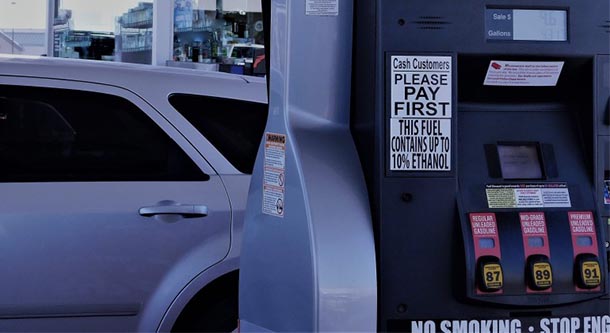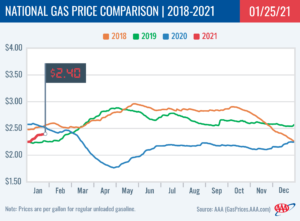
WASHINGTON, D.C. (January 25, 2021) –According to the latest Energy Information Administration (EIA) measurement, gasoline demand jumped from 7.53 million b/d to 8.11 million b/d. Typically a significant increase in demand results in a comparable decrease in supply, ultimately translating to more expensive pump prices. Surprisingly, the recent large jump in demand had little impact on gasoline supply and minimal impact on pump prices. For the week ending January 20, gasoline supply saw a small decrease of 300,000 bbl. At 245 million bbl, supply levels lag behind last year’s reading at this time by 15 million bbl.
At the pump, the national average increased by two cents on the week to $2.40. Five states saw gas prices decrease – Michigan (-5 cents), Indiana (-5 cents), Ohio (-2 cents), North Carolina (-1 cent) and Delaware (-1 cent); while the rest of the country saw nominal increases. Moreover, only three states saw gas price averages increase more than a nickel.
“Most motorists continue to see gas prices increase, but at a slower rate than the past few weeks,” said Jeanette Casselano McGee, AAA spokesperson. “Part of that is due to more stable crude oil prices throughout January. However, if demand continues another week of substantial increases, we can expect to see pump prices get more expensive.”
With the national average 15 cents more expensive than this time last month, every state gas price average is more expensive than December. Year-over-year, motorists are still saving at the pump, on average about 12 cents, with the exception of Maryland (+4 cents).

Quick Stats
The nation’s top 10 largest weekly increases: Florida (+9 cents), Utah (+9 cents), Nebraska (+5 cents), Idaho (+4 cents), Louisiana (+4 cents), California (+3 cents), Illinois (+3 cents), Nevada (+3 cents), Kentucky (+3 cents) and Connecticut (+3 cents).
- The nation’s top 10 least expensive markets: Mississippi ($2.09), Oklahoma ($2.11), Texas ($2.11), Missouri ($2.12), Louisiana ($2.14), South Carolina ($2.16), Arkansas ($2.17), Alabama ($2.17), Kansas ($2.18) and Tennessee ($2.19).
Oil Market Dynamics
At the close of Friday’s formal trading session, WTI decreased by 86 cents to settle at $52.36. Crude prices declined last week following market concern that crude demand may suffer as coronavirus infections rise and travel restrictions, which are meant to curb transmission of the virus, reduce crude demand. Additionally, EIA’s latest weekly report revealed that total domestic crude inventories rose by 4.4 million bbl to 486.6 million bbl, which also put downward pressure on crude prices. For this week, crude prices may continue to drop if market concern regarding demand continues to grow.
Motorists can find current gas prices along their route with the free AAA Mobile app for iPhone, iPad and Android. The app can also be used to map a route, find discounts, book a hotel and access AAA roadside assistance. Learn more at AAA.com/mobile.
